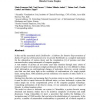2666 search results - page 165 / 534 » Computing with Evolving Proteins |
BMCBI
2008
14 years 10 months ago
2008
Background: A multiple sequence alignment (MSA) generated for a protein can be used to characterise residues by means of a statistical analysis of single columns. In addition to t...
CORR
2010
Springer
14 years 8 months ago
2010
Springer
In this and the associated article BioBlender: A Software for Intuitive Representation of Surface Properties of Biomolecules [1], we present BioBlender as a complete instrument fo...
RECOMB
2007
Springer
15 years 10 months ago
2007
Springer
Transcription factor (TF) binding to its DNA target site is a fundamental regulatory interaction. The most common model used to represent TF binding specificities is a position spe...
84
Voted
ISBRA
2010
Springer
15 years 4 months ago
2010
Springer
d abstract), Nicola Ferraro, Luigi Palopoli, Simona Panni and Simona E. Rombo. Uncovering Hidden Phylogenetic Consensus d abstract), Nicholas Pattengale, Krister Swenson and Bernar...
CIBCB
2005
IEEE
15 years 3 months ago
2005
IEEE
— Part of the challenge of modeling protein sequences is their discrete nature. Many of the most powerful statistical and learning techniques are applicable to points in a Euclid...


